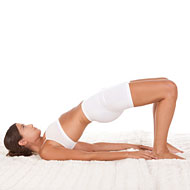- Aromatherapy (36)
- Benefits of Yoga (282)
- Home Remedies (1087)
- massage therapy (9)
- Preventive Therapy (135)
- Running (41)
- Skin Care (15)
- Stress Relief (25)
- Stretching (5)
- walking (33)
- Womens Health (14)
- Yoga Benefits for Pregnant Women (16)
- Yoga Benefits for Students (3)
- Yoga for Children (11)
- Yoga for Holistic Living (37)
- Yoga for Midlife Crisis (3)
- Yoga for Senior Citizens (2)
- Yoga for the Workplace (1)
- Yoga Health Tips (185)
- Yoga Practice during Menstruation (5)
Yoga Exercises For Cervical Problems

The cervical vertebrae extend from the base of the skull to the upper back. It consists of seven vertebrae and eight pairs of cervical nerves. Incorrect posture and lack of exercise cause the cervical spine to get misaligned. This can lead to variety of problems that manifest themselves in the form of neck pain, a stiffening of the shoulder muscles, and may eventually lead to Cervical Spondylitis.
The incidence of cervical problems is on the rise throughout the world due to long hours spent hunched over a computer screen in office. Even at home, watching television while lying on the bed with pillows propped up aggravates this problem. Lack of exercise is another contributor to cervical problems. Patients with cervical problems have stiff neck and shoulder muscles. They are unable to stretch the neck backwards.
The best way to cure cervical problems is to restore flexibility to these stiff muscles. Yoga is one of the most ideal methods of dealing with cervical problems. Regular practice of Yoga is more effective than allopathic medicine, or conventional traction in reducing the pain associated with this condition. If you have never exercised before, do consult your physician before embarking on a Yoga program.
Yoga Postures For Cervical Vertebrae
Yoga exercises utilize a lot of back bends which help to widen the inter-vertebral spaces, thereby eliminating cervical ailments. Inverted postures strengthen the muscles of the cervical region, thereby enabling them to bear the weight of the head with ease. Postures that gently twist the spine help to get rid of the stiffness in the dorsal and cervical area. Poses such as the Vajra Asana (Diamond pose), Dhanura Asana (Bow pose), Sarvanga Asana (Shoulder stand) and Hala Asana (Plough pose) are very effective in alleviating cervical discomfort.
Patients with cervical problems should use slightly modified Yoga poses that will give even greater benefit. For example, when performing head stands, it should be ensured that the forehead is placed on the ground. This gently stretches the cervical spine and helps to ease the pain. Shoulder stands should be performed with the help of a chair. Belts and ropes may be used to provide additional traction for speedy relief.
It is a good idea to seek advice from a qualified Yoga teacher, as he or she will be able to guide you with regard to the correct exercises to be performed to deal with cervical problems. Solely relying on books or DVD’s to learn Yoga may actually aggravate the problem and result in more pain and injury.
- RSS Feeds -
- All posts
- All comments
- Cure Cervical Cancer through Diet, Yoga and Meditation Over many years, cells lining the surface of the cervix go through a series of c...
- Acupuncture For Cervical Spondylosis Spondylosis is the medical term for arthritis of the spine. This is a degener...
- Exercises For Women Of All Ages Yoga has been proven to be of great benefit for women of different ages. All ...
- Yoga For Children With Breathing Difficulties There is no standard definition for "breathing difficulties in children&...